
|   |

|   |
 e-mail: janakipatrik@gmail.com Choreographing SRINGAR - The Raja Rasa January 24, 2023 SRINGAR - The Raja Rasa. LOVE ... King of Romantic Sentiments ... Ruler of Erotic Emotions. LOVE ...... the emotion from which all other emotions are said to emanate. No words can speak as eloquently as photographs can reveal .... the profound differences in choreographic expressions of Sringar Rasa in classical north Indian Kathak and in western modern dance and classical ballet. The tender eloquence of interlocked eyes and restrained lack of physical contact in Birju Maharaj and Kumudini Lakhia's Kathak duet contrast with the wild abandon and melding of bodies in Suzanne Farrell and Peter Martins duet from George Ballanchine's ballet CHACONNE and the primeval animal innocence suggested in Merce Cunningham and Meg Harper's duet in RAINFOREST. 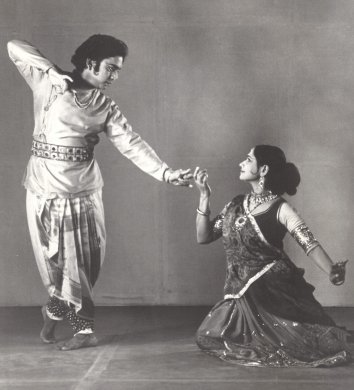 Pt. Birju Maharaj & Kumudini Lakhia in RATI KAMDEV Choreography-Birju Maharaj 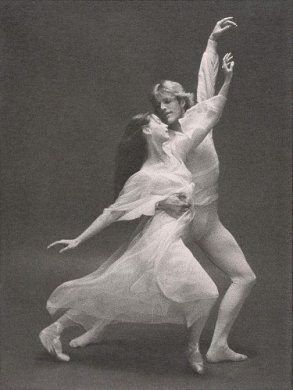 Suzanne Farrell and Peter Martins in CHACONNE Choreography-George Balanchine. Photo by Max Waldman 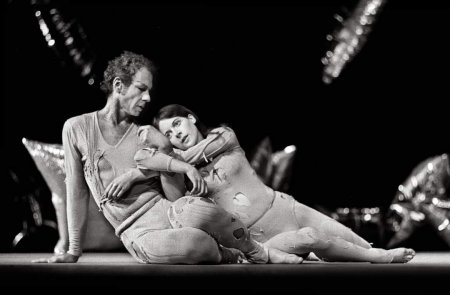 Merce Cunningham & Meg Harper in RAINFOREST - Choreography-Merce Cunningham Photo by James Klosty Studying all three dance techniques and watching productions emanating from their movement vocabularies, I've developed my own choreographic vocabulary. I've never aimed for stylistic "purity". I don't believe in it. Dance styles need to breathe with the times, otherwise they die. Two productions which I've created for my dance company, The Kathak Ensemble & Friends, display my syncretic choreographic vision. FLASHPOINT In 2010 the W.H.Auden Estate finally loosened its restrictions on the use of Auden's magnificent love poem LULLABY (written in 1939), and the Estate issued a license to the Kathak Ensemble to use the poem in choreography. To provide context for Auden's poem, I created a full-evening production entitled FLASHPOINT, referring to the temperature at which an object or idea catches fire. FLASHPOINT Part I, POWER, explored the heroic power of the 14 beat rhythm cycle Taal Dhamar and the cosmic power displayed by Shiv Nataraj, Shiva, Lord of the Dance in Shiv Vandana. Translated from the original Sanskrit.
FLASHPOINT Part II, LOVE - Kavit included a traditional Kathak depiction of love - a solo rendition of the kavit Vahi he kadamba / There is the kadamba tree by the 19th Century Lucknow Gharana poet Bindadin Maharaj. In his kavit Bindadin encapsulated the nostalgic sorrow for lost love between idealized lovers - the archetypal human beloved - Radha - and the divine lover Krishna. Remembering her youthful love play with Krishna, Radha - who has touched and then lost the ineffable divine - laments:
FLASHPOINT Part II, LOVE - Lullaby - The kavit's celebration of romantic love between divinity and human contrasts with the unsentimental picture of ephemeral, imperfect human love in W.H. Auden's 1940 poem Lullaby.
The movement vocabulary I used to illuminate Auden's poem was inspired by Kathak's abhinaya techniques, but it ranged far outside the boundaries of classical Kathak. The unsentimental realism of Auden's poem was accompanied by the unhurried musical phrasing and lyrical melodies of Samuel Barber's CONCERTO FOR VIOLIN and ORCHESTRA (1939/1940). As in many Kathak Ensemble productions, the chosen dancers brought a variety of training into the choreographic process, as well as adventurous spirits willing to try all the movements and rhythms I presented. The choreographic stew included Bharata Natyam, Kathak, American modern and tap dance, ballet, Broadway dance, ballroom dance, Rabindra-nritya, as well as Bangladeshi, Japanese, American and European folk dance. My choreography didn't copy literal steps of those techniques, but it suggested their movement qualities and archetypal cultural images. The individuality of each dancer is celebrated. FLASHPOINT Parts I & II - excerpts from 19 March 2010 @ Alvin Ailey Citigroup Theater - YouTube LULLABY 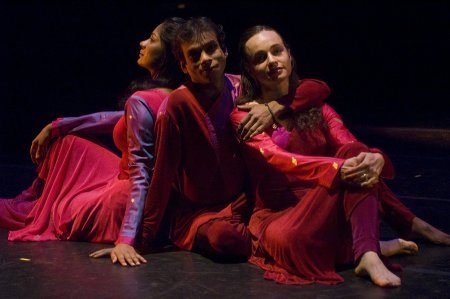 Lullaby - Sandhya Menon - Anup Kumar Das - Caron Eule. Photo © Ira Landgarten 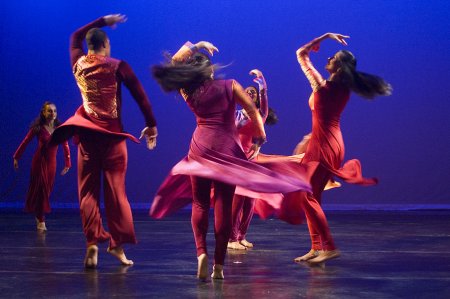 Lullaby - Caron Eule - Scott Lewis - Ahnya Chang - Sandhya Menon - Sowmya Viswanath. Photo © Ira Landgarten 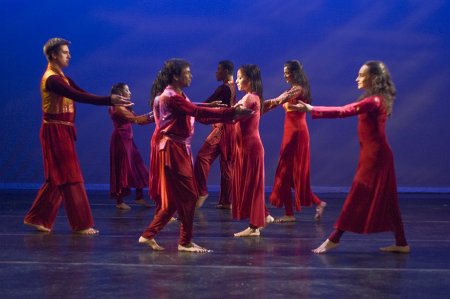 Lullaby - Matthew Wagner - Ahnya Chang - Sandhya Menon (partially obscured) - Anup Kumar Das - Scott Lewis (background) - Yayoi Suzuki - Sowmya Viswanath - Caron Eule. Photo © Ira Landgarten  Lullaby - Caron Eule (incomplete image) - Scott Lewis - Sowmya Viswanath - Matthew Wagner. Photo © Ira Landgarten 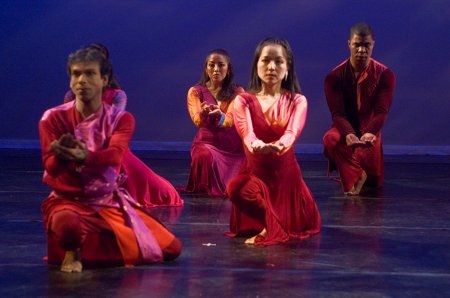 Lullaby - Anup Kumar Das - Sandhya Menon (hidden behind Anup) - Ahnya Chang - Yayoi Suzuki - Scott Lewis. Photo © Ira Landgarten TOCCARE - Touch To create a contrasting companion piece for the meditative lyricism of LULLABY, I choreographed the final movement of John Adams' VIOLIN CONCERTO. Entitled TOCCARE - literally "touch" - this section was danced at the same breakneck speed played by Gidon Kremer on his recording of the piece. As the lights came up at the beginning of TOCCARE, Anup stood alone for two seconds in a pose reminiscent of Merce Cunningham's iconic pose from his choreography HOW TO PASS, KICK, FALL and RUN. 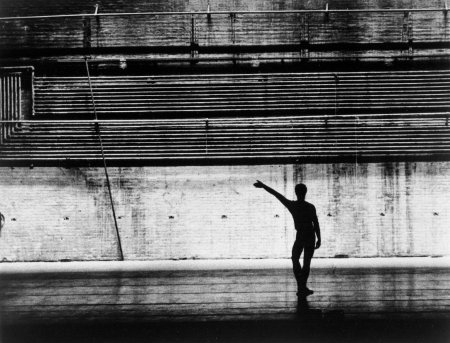 Merce Cunningham in his choreography HOW TO PASS, KICK, FALL and RUN - Photo © James Klosty & The Merce Cunningham Trust 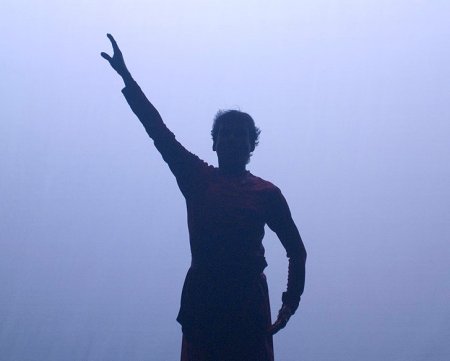 Anup Kumar Das in TOCCARE / Touch - Photo © Ira Landgarten Anup then sprang into action, leading the dancers in a rollicking romp. His hijinks were meant to evoke the spirit of Shakespeare's Puck, the instigator of mischief in Midsummer Night's Dream. Interweaving and intertwining, the dancers touched each other in joyous abandon. 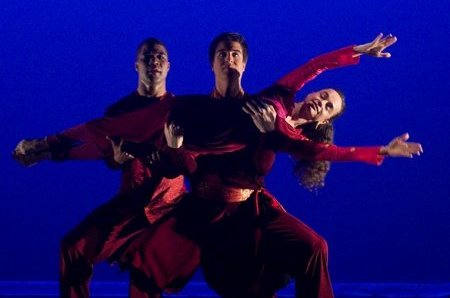 TOCCARE / Touch - Scott Lewis - Matthew Wagner - Caron Eule. Photo © Ira Landgarten 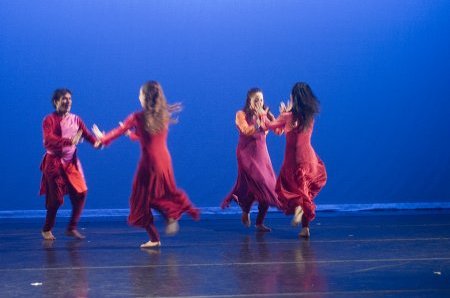 TOCCARE / Touch - Anup Kumar Das - Caron Eule - Ahnya Chang - Yayoi Suzuki. Photo © Ira Landgarten 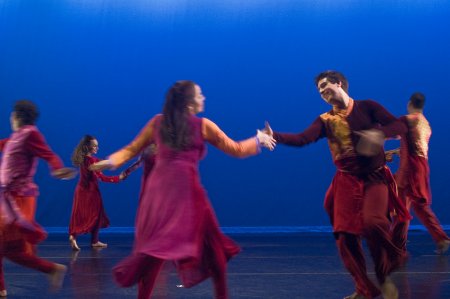 TOCCARE / Touch - Anup Kumar Das - Caron Eule (background) - Ahnya Chang - Matthew Wagner - Scott Lewis (background). Photo © Ira Landgarten  TOCCARE / Touch - Sowmya Viswanath & Matthew Wagner. Photo © Ira Landgarten 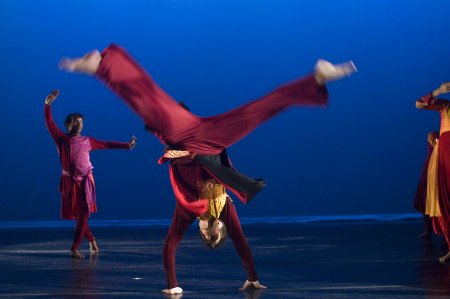 TOCCARE / Touch - Anup Kumar Das - Matthew Wagner. Photo © Ira Landgarten 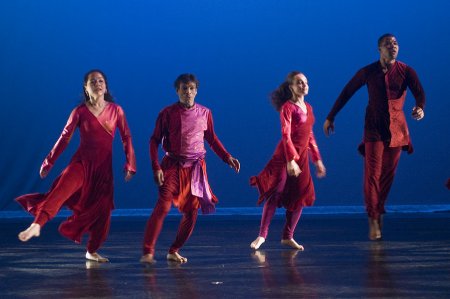 TOCCARE / Touch - Yayoi Suzuki - Anup Kumar Das - Caron Eule - Scott Lewis. Photo © Ira Landgarten 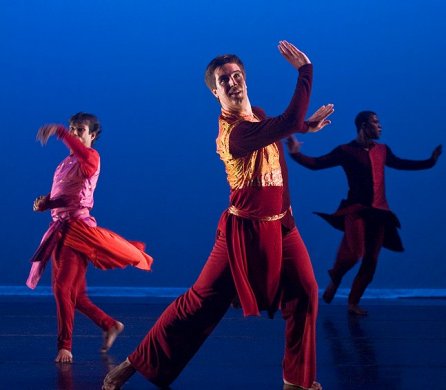 TOCCARE / Touch - Anup Kumar Das - Matthew Wagner - Scott Lewis. Photo © Ira Landgarten 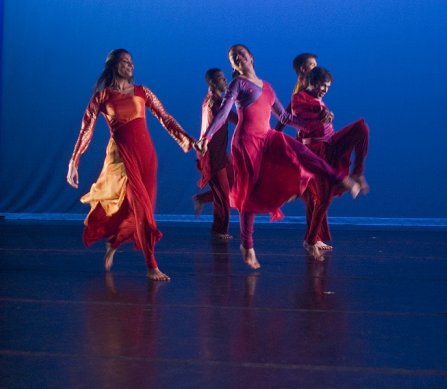 TOCCARE / Touch - Sowmya Viswanath - Scott Lewis (background) - Chie Mukai -Matthew Wagner (behind - only head is visible) - Anup Kumar Das. Photo © Ira Landgarten Ashta Nayika - "the eight heroines" - a systematic classification of characteristics of women in love - first appeared in the Natya Shastra, a foundational Sanskrit treatise on Indian performing arts. Dated loosely between the 5th / 2nd century BCE and 2nd / 5th century CE, its authorship is attributed to the dramatist-sage Bharata. Listing the names of the eight nayikas and their relation to their eight corresponding nayakas highlights the male-centric nature of this seminal classification system, which has generated seemingly infinite variations in Indian performing and pictorial arts. The avastha - a word defined as "situations, states, conditions, circumstances" -- of the eight women in love can be broadly summarized as follows: Vasakasajja - one dressed up for union Virahotkanthita - one distressed by separation Svadhinabhartruka - one having her husband in subjection Kalahantarita - one separated by a quarrel Khandita - one enraged with her lover Vipralabdha - one deceived by her lover Proshitabhartruka - one whose husband is away on a journey Abhisarika - one going to meet her love, despite obstacles I've frequently felt uncomfortable while reading poetry, watching performances and listening to music lyrics based on the concept of Ashta Nayika. As a modern woman I've mentally resisted the paternalistic, patriarchal point of view expressed in many of these iterations. I've inwardly cringed, when the dancer depicting a particular nayika displayed coy modesty and girlish behavior in order to please or manipulate the male beloved, who is physically absent in India's solo dance forms. In the hands of inexperienced dancers, such abhinaya seems to me like mawkish posturing. As a modern woman I've avoided performing and teaching some of the traditional Kathak repertoire based on ashta nayika archetypes, because the woman is rarely in a position of agency - except perhaps in an underhanded, manipulative manner. Most often she is reacting to the man - waiting for him to motivate her next actions and emotional reactions; waiting for the man to resolve her sorrow or anger or longing or anticipated pleasure. Compounding my discomfort with this genre is the knowledge, that the girlish reactions to romantic situations might reflect interactions between nayikas and nayakas in a time of arranged marriages between barely pubescent girls and much older men. And yet ... why do I often feel, while watching an inspired performance based on one of the Ashta Nayikas, that the situation is familiarly true-to-life, and that I've "been there, done that"? Why do I, a 21st Century woman, find that male and female lovers are still playing roles similar to those described by the ancient ashta nayika archetypes and exhibiting similar emotions in their relationships? When an illuminating performance is based on an ashtapadi from Jayadeva's (born c. 1170) Gita Govinda or poetry in Keshavdas' (1555-1617) Rasikapriya , the eternal truth of the archetypes shines through. I think that my discomfort with some current ashta nayika depictions reflects the disjoint between fundamental human emotions and the out-dated situations in many dramatizations. Human emotions - actions and reactions - attractions and repulsions - are deeply rooted. They are part of our DNA and our cultural histories. We don't need to be "liberated" from our emotions. We need to update the dramatizations of our human emotions, so that they more realistically reflect our modern reality. RE-FRAMING ASHTA NAYIKA The Kathak Ensemble's 2013 production PREMIKA: Women in Love reframed the concept of ashta nayika. Dressed in modern clothing, the actor Priyanka Nishar introduced each episode. Speaking aloud, as if the audience could listen to her inner thoughts, Priyanka dramatized each development in her modern romance. The progression of situations and emotions -- rather than a checklist of the eight nayikas -- dictated the choice of music and choreography. Some of the songs were chosen from popular Bollywood movies, some from the traditional Lucknow Kathak repertoire. All were re-recorded by a single ensemble of musicians, allowing for a balanced sound and a unified narrative voice. Vocal: Vidushi Mitali Banerjee Bhawmik - Sarangi: Pandit Ramesh Misra - Tabla: Narendra Budhkar - Sitar: Indrajit Roy-Chowdhury - Bansuri: Eric Fraser - Vocal support: Manoj Govindraj 1. Spoken DRAMATIZATION
Music & Lyrics Rubai Sargam - Raag Malkauns - Mukt chand & Teentaal
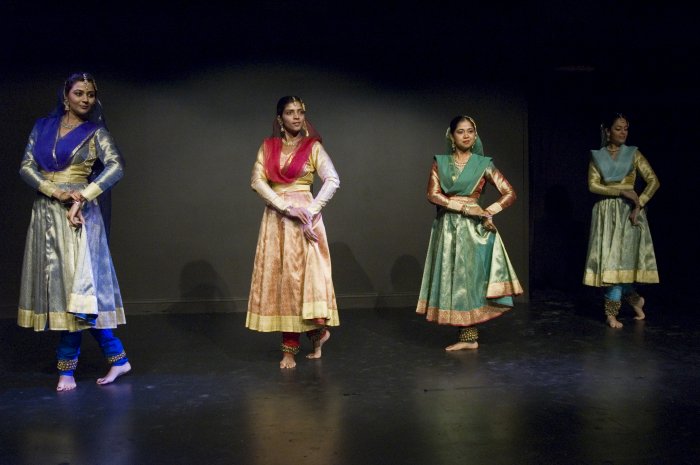 Sowmya Viswanath - Neha Kulkarni - Rashi Verma - Anisha Muni Photo © Ira Landgarten 2. Spoken DRAMATIZATION
Music & Lyrics Saanware aai jaiyo - Please come beloved dark one.... Raag Maanj Khamaaj ; Keherwa taal This thumri is attributed to Dr.VasantRao Deshpande and popularized by many classical singers, including Pt. Kumar Gandharva and Dr. Prabha Atre. Dr. Atre notes that this song may have roots in folk songs of Madhya Pradesh. In the 1996 Bollywood film YESHWANT, the music and lyrics of the song are attributed to A R Rehman.
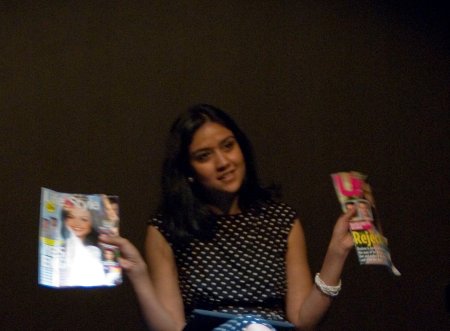 Priyanka Nishar - "I've been looking for love .... " Photo © Ira Landgarten 3. Spoken DRAMATIZATION
Music & Lyrics Jaane de maika suno sajanawa Let me go to my mother's house Raag shahana kanada - Teentaal Poetry-Bindadin Maharaj Music- Bindadin Maharaj & Pt. Birju Maharaj
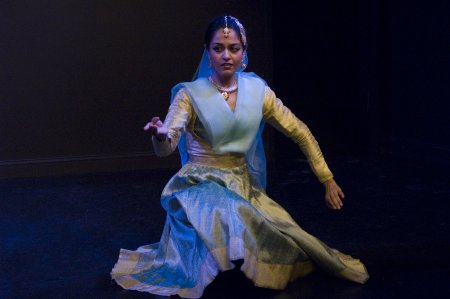 Anisha Muni, "You are always quarreling with me & don't listen.." Photo © Ira Landgarten 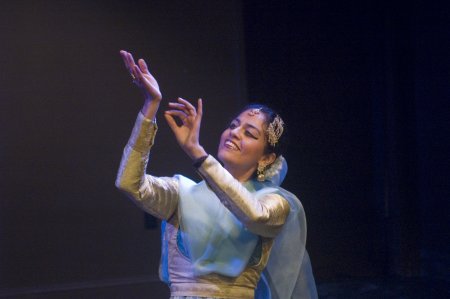 "My beautiful bangles" Photo © Ira Landgarten
Music & Lyrics Aaj jaane ki zid na karo - Tonight, don't insist on leaving Raag Yaman ; Taal Deepchandi Music & Lyrics - Fayyaz Hashmi
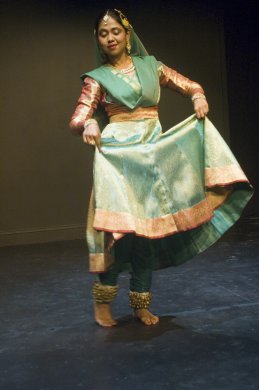 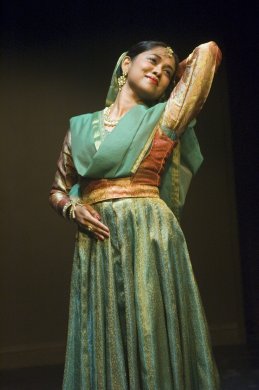 Rashi Verma, "The ambiance is so innocent, so beautiful ...passion and beauty reign" Photos © Ira Landgarten 5. Spoken DRAMATIZATION
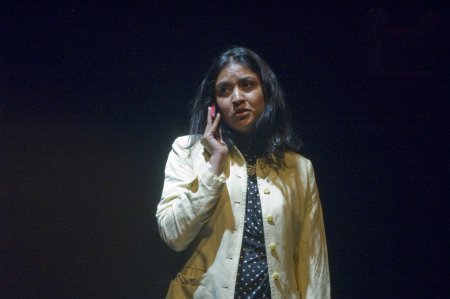 Priyanka Nishar, "You'll be away ANOTHER six months ....?" Photo © Ira Landgarten Music & Lyrics Ghar nahin hamare shyam - My beloved is not home Based on Raag Nand ; Taal Sitarkhani Lyrics - Javed Akhtar, Music - Vanraj Bhatia
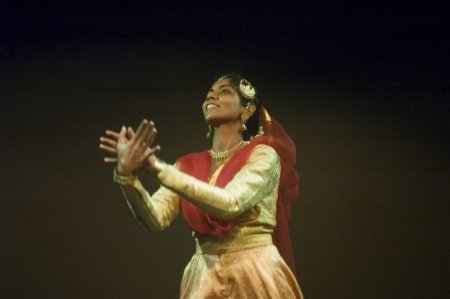 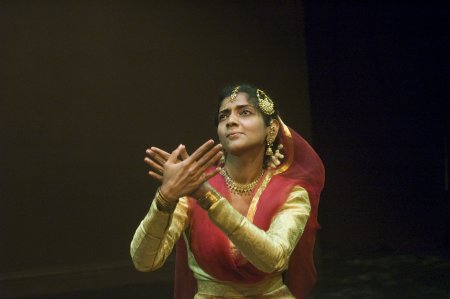 Neha Kulkarni, "The cruel cuckoo bird ... sings my beloved's name ...." Photos © Ira Landgarten 6. Spoken DRAMATIZATION
Music & Lyrics Kahe ko mere ghar aaye ho Raag Basant Bahar, modulating to Sohani ; Teentaal Poetry - Bindadin Maharaj Music - Bindadin Maharaj & Pt. Birju Maharaj
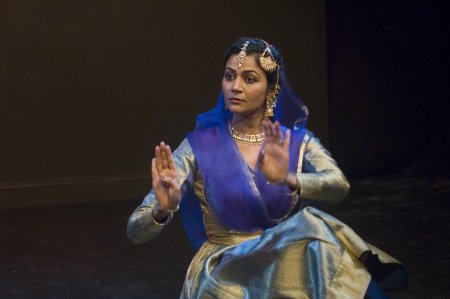 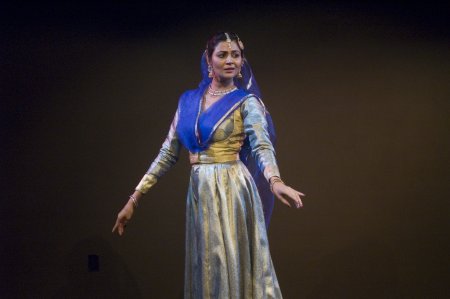 Sowmya Viswanath, "You spent the night with my rival ..." "Don't fall at my feet ..." Photos © Ira Landgarten 7. Spoken DRAMATIZATION
Music & Lyrics Piya bina - Without my beloved ... Raag Pahari ; Taal Keherwa & Bhajani Lyrics - Majrooh Sultanpuri, Music S.D.Burman, rendered in semi-classical style by Vidushi Mitali Banerjee Bhawmik
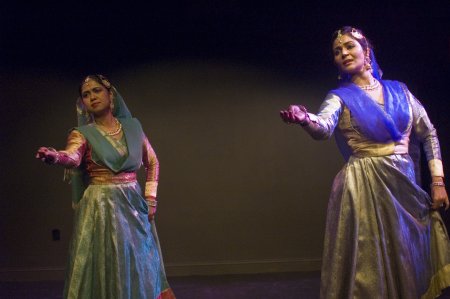 Rashi Verma & Sowmya Viswanath, "My beloved left me ....." Photo © Ira Landgarten 8. Spoken DRAMATIZATION
Music & Lyrics Alabela sajana aayo re - The beautiful beloved has come adorned Raag Ahir Bhairav ; Teentaal Poetry & Music - "Manarang"
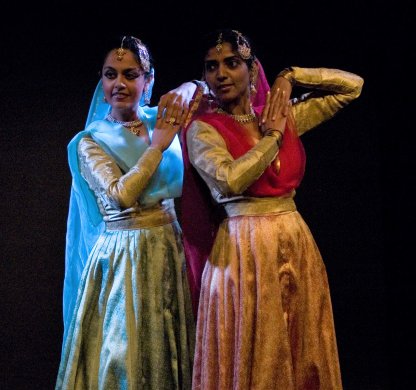 Anisha Muni & Neha Kulkarni, "The beautiful beloved has come adorned......" Photo © Ira Landgarten 9. Spoken DRAMATIZATION
Music & Lyrics Hazaaron khwahiishen - Thousands of dreams Raag Kalavati ; TARANA in Ektaal Poetry - Mirza Ghalib Ghalib (born in Agra 1797, died in Delhi 1869). Music for sher composed by Vidushi Mitali Banerjee Bhawmik with Pandit Ramesh Misra Music for tarana - Composed by Devi & Durga Lal, arranged by Narendra Budhkar
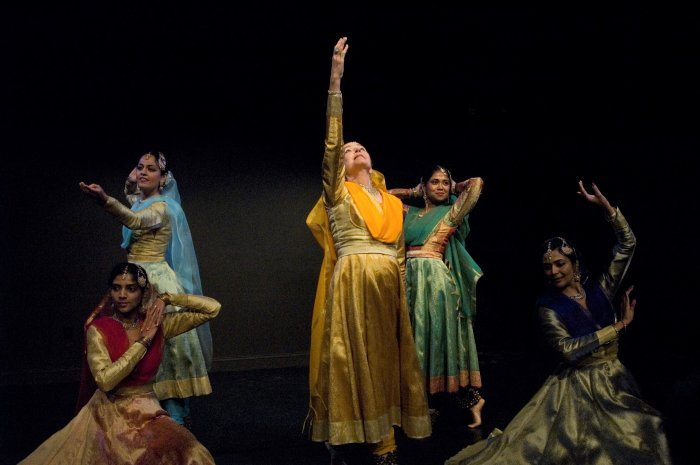 Neha Kulkarni - Anisha Muni - Janaki Patrik - Rashi Verma - Sowmya Viswanath "Many dreams I have realized ...... yet I yearn for more ...." Photo © Ira Landgarten  Trained in both classical Kathak dance (Pt. Birju Maharaj, beginning 1967) and Merce Cunningham modern dance technique (1971 to 1978), Janaki Patrik has choreographed thirty full-evening productions and numerous shorter works exploring an eclectic range of poetry, mythic storytelling and music. She is the Artistic Director and Founder (1978) of The Kathak Ensemble & Friends/CARAVAN, NYC. A dedicated teacher, Janaki has trained dancers to perform an extensive repertoire of classical Kathak, as well as her new choreography. Teaching and performing in inner-city schools through Urban Gateways/Chicago and Young Audiences/New York for forty years, Janaki has embodied the power of dance and music to communicate the interconnections of all cultures. Post your comments Please provide your name along with your comment. All appropriate comments posted with name & email id in the blog will also be featured in the site. |